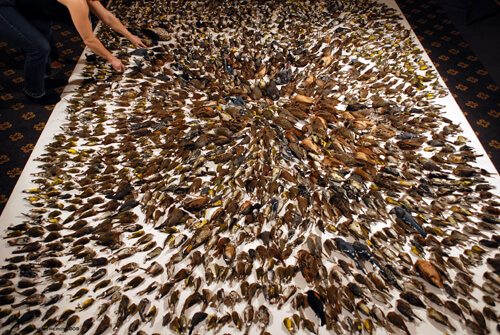Landmark Trial Underway Over Worst Bird Killing Buildings in Toronto, Canada
MEDIA RELEASE
Contact: Robert Johns, 202-234-7181 ext.210, bjohns@abcbirds.org
 |
Window-killed birds collected by FLAP from a few buildings in Toronto. Photo: Kenneth Herdy |
(Washington, D.C.,
The case pits the owners of three adjoining, 17-19-story glass office buildings – Consilium Place Towers – against two environmental groups – Ecojustice and Ontario Nature. Those groups claim that the buildings, whose exterior faces are almost entirely all glass, are responsible the deaths of about 7,000 birds in the last decade, making them the most deadly in the entire Greater Toronto Area.
“This is probably the first case of its kind in North America and it is not hard to see how it could have long-term impacts across Canada and perhaps elsewhere. While laws and politics are certainly different in each country, this trial could provide insights into how wildlife and environmental laws can be better enforced here in the U.S.,” said George Fenwick, President of American Bird Conservancy (ABC), the leading bird conservation organization in the United States.
Menkes Consilium Inc., Menkes Developments Ltd., and Menkes Property Management Services Ltd., along with three other companies, have been charged under Ontario’s Environmental Protection Act with discharging a contaminant that causes harm to animals. That contaminant? The light reflected from the windows.
The lawsuit followed lengthy, failed attempts to negotiate a settlement. The maximum fine under the act is $6 million per day for a first offense. The companies also face a maximum fine of $60,000 under the Ontario Society for the Prevention of Cruelty to Animals Act for causing birds to be in distress.
According to ABC, up to one billion bird deaths are thought to occur from collisions with glass on buildings in the United States alone. There are three principal problems with building windows that lead to bird fatalities: (1) birds try to fly to sky, trees or structures reflected in the glass’ mirror-like surface; (2) where windows are situated on opposite sides of a building or perpendicular to each other on building corners, birds try to fly to sky or vegetation seen through the building and (3) birds are attracted to the areas around buildings when lights are left on at night (a major problem in many urban areas in North America).
“Many of us have at one time or another, walked into a glass door, so we know how jarring that is to our bodies just at walking speed. Try to imagine hitting that same pane at 30 miles per hour, thirty or more feet off the ground. It’s not surprising that so many bird collisions prove fatal,” Fenwick said.
According to the Canadian non-profit group FLAP (Fatal Light Awareness Program), each year in Toronto, over one million birds are killed in collisions with building windows, the majority during spring and fall migrations. Toronto is located in a major migratory bird corridor, and has had guidelines in place for a number of years to encourage building owners to take action, including applying transparent window coverings and turning lights off at night.


















































